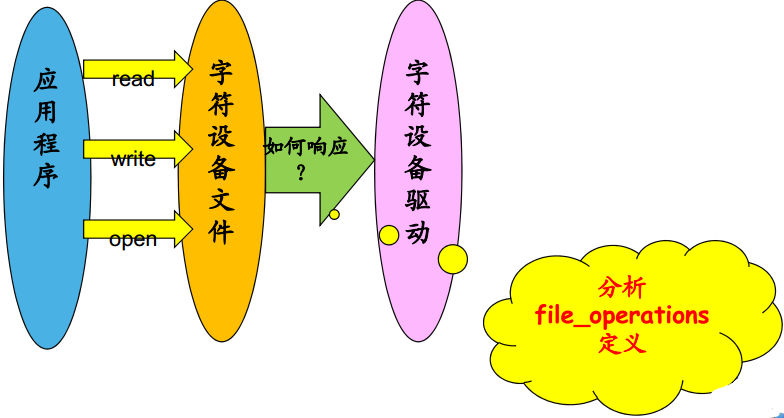7.字符设备驱动编程模型
字符设备驱动编程模型

在Linux系统中,设备的类型非常繁多,如:字符设备,块设备,网络接口设备,USB设备,PCI设备,平台设备,混杂设备… ,而设备类型不同,也意味着其对应的驱动程序模型不同,这样就导致了我们需要对应的驱动程序模型不同,这样就导致了我们需要去掌握众多的驱动程序模型。那么能不能从这些众多的驱动模型中提炼出一些具有共性的规则,则是我们能不能学好Linux驱动的关键。
一、设备描述结构
在任何一种驱动模型中,设备都会用内核中的一种结构来描述。我们的字符设备在内核中使用struct cdev来描述。
1 struct cdev { 2 struct kobject kobj; 3 struct module *owner; 4 const struct file_operations *ops; //设备操作集 5 struct list_head list; 6 dev_t dev; //设备号 7 unsigned int count; //设备数 8 };
1.1设备号
1.1.1主设备号
字符设备文件与字符驱动程序通过主设备号建立关系的桥梁
1.1.2次设备号
驱动程序通过次设备号来区分同一种设备(比如串口1和串口2)
1.1.3设备号操作
Linux内核中使用dev_t类型来定义设备号,dev_t这种类型其实质为32位的unsigned int,其中高12位为主设备号,低20位为次设备号.
知道主设备号,次设备号,组合成dev_t类型:
dev_t dev = MKDEV(主设备号,次设备号)
从dev_t中分解出主设备号:
主设备号 = MAJOR(dev_t dev)
从dev_t中分解出次设备:
次设备号=MINOR(dev_t dev)
1.1.4设备号分配
1.静态申请
开发者自己选择一个数字作为主设备号,然后通过函数register_chrdev_region向内核申请使用。缺点:如果申请使用的设备号已经被内核中的其他驱动使用了,则申请失败。
2.动态申请
使用alloc_chrdev_region由内核分配一个可用的主设备号。优点:因为内核知道哪些号已经被使用了,所以不会导致分配到已经被使用的号。
1.1.5设备号注销
不论使用何种方法分配设备号,都应该在驱动退出时,使用unregister_chrdev_region函数释放这些设备号。
1.2操作函数集

结构体原型:
1 struct file_operations { 2 struct module *owner; 3 loff_t (*llseek) (struct file *, loff_t, int); 4 ssize_t (*read) (struct file *, char __user *, size_t, loff_t *); 5 ssize_t (*write) (struct file *, const char __user *, size_t, loff_t *); 6 ssize_t (*aio_read) (struct kiocb *, const struct iovec *, unsigned long, loff_t); 7 ssize_t (*aio_write) (struct kiocb *, const struct iovec *, unsigned long, loff_t); 8 int (*readdir) (struct file *, void *, filldir_t); 9 unsigned int (*poll) (struct file *, struct poll_table_struct *); 10 long (*unlocked_ioctl) (struct file *, unsigned int, unsigned long); 11 long (*compat_ioctl) (struct file *, unsigned int, unsigned long); 12 int (*mmap) (struct file *, struct vm_area_struct *); 13 int (*open) (struct inode *, struct file *); 14 int (*flush) (struct file *, fl_owner_t id); 15 int (*release) (struct inode *, struct file *); 16 int (*fsync) (struct file *, int datasync); 17 int (*aio_fsync) (struct kiocb *, int datasync); 18 int (*fasync) (int, struct file *, int); 19 int (*lock) (struct file *, int, struct file_lock *); 20 ssize_t (*sendpage) (struct file *, struct page *, int, size_t, loff_t *, int); 21 unsigned long (*get_unmapped_area)(struct file *, unsigned long, unsigned long, unsigned long, unsigned long); 22 int (*check_flags)(int); 23 int (*flock) (struct file *, int, struct file_lock *); 24 ssize_t (*splice_write)(struct pipe_inode_info *, struct file *, loff_t *, size_t, unsigned int); 25 ssize_t (*splice_read)(struct file *, loff_t *, struct pipe_inode_info *, size_t, unsigned int); 26 int (*setlease)(struct file *, long, struct file_lock **); 27 long (*fallocate)(struct file *file, int mode, loff_t offset, 28 loff_t len); 29 };
Struct file_operations是一个函数指针的集合,定义能在设备上进行的操作。结构中的函数指针指向驱动中的函数, 这些函数实现一个针对设备的操作, 对于不支持的操作则设置函数指针为 NULL。例如:
struct file_operations dev_fops ={
.llseek = NULL,
.read = dev_read,
.write = dev_write,
.ioctl = dev_ioctl,
.open = dev_open,
.release = dev_release,
};
二、字符设备驱动模型
2.1驱动初始化
2.1.1分配
cdev变量的定义可以采用静态和动态两种办法
• 静态分配
struct cdev mdev;
• 动态分配
struct cdev *pdev = cdev_alloc();
2.1.2初始化
struct cdev的初始化使用cdev_init函数来完成。
cdev_init(struct cdev *cdev, const struct file_operations *fops)
参数:
cdev: 待初始化的cdev结构
fops: 设备对应的操作函数集
2.1.3注册
字符设备的注册使用cdev_add函数来完成。
cdev_add(struct cdev *p, dev_t dev, unsigned count)
参数:
p: 待添加到内核的字符设备结构
dev: 设备号
count: 该类设备的设备个数
2.1.4硬件初始化
2.2分析实现设备操作
2.2.1设备操作原型
1 int (*open) (struct inode *, struct file *) 2 打开设备,响应open系统
open设备方法是驱动程序用来为以后的操作完成初始化准备工作的。在大部分驱动程序中,open完成如下工作:
标明次设备号
启动设备
1 int (*release) (struct inode *, struct file *); 2 关闭设备,响应close系统调用
release方法的作用正好与open相反。这个设备方法有时也称为close,它应该:关闭设备。
1 loff_t (*llseek) (struct file *, loff_t, int) 2 重定位读写指针,响应lseek系统调用
1 ssize_t (*read) (struct file *, char __user *, size_t, loff_t *) 从设备读取数据,响应read系统调用
read设备方法通常完成2件事情:
从设备中读取数据(属于硬件访问类操作)
将读取到的数据返回给应用程序
ssize_t (*read) (struct file *filp, char __user *buff, size_t count, loff_t *offp)
参数分析:
filp:与符设备文件关联的file结构指针, 由内核创建。
count: 请求传输的数据量,由read系统调用提供该参数。
offp: 文件的读写位置,由内核从file结构中取出后,传递进来。
buff : 从设备读取到的数据,需要保存到的位置。由read系统调用提供该参数。
buff参数是来源于用户空间的指针,这类指针都不能被内核代码直接引用,必须使用专门的函数
int copy_from_user(void *to, const void __user *from, int n) //写入内核
int copy_to_user(void __user *to, const void*from, intn) //写到用户空间
1 ssize_t(*write) (struct file *, const char __user *,size_t,loff_t *) 2 向设备写入数据,响应write系统调用
write设备方法通常完成2件事情:
从应用程序提供的地址中取出数据
将数据写入设备(属于硬件访问类操作)
ssize_t (*write) (struct file *, const char __user *, size_t, loff_t *)
其参数类似于read
2.2.2struct file
在Linux系统中,每一个打开的文件,在内核中都会关联一个struct file,它由内核在打开文件时创建, 在文件关闭后释放。
重要成员:
loff_t f_pos /*文件读写指针*/
struct file_operations *f_op /*该文件所对应的操作*/
2.2.3Struct inode
每一个存在于文件系统里面的文件都会关联一个inode 结构,该结构主要用来记录文件物理上的信息。因此, 它和代表打开文件的file结构是不同的。一个文件没有被打开时不会关联file结构,但是却会关联一个inode 结构。
重要成员:
dev_t i_rdev:设备号
2.3驱动注销
当我们从内核中卸载驱动程序的时候,需要使用cdev_del函数来完成字符设备的注销。



